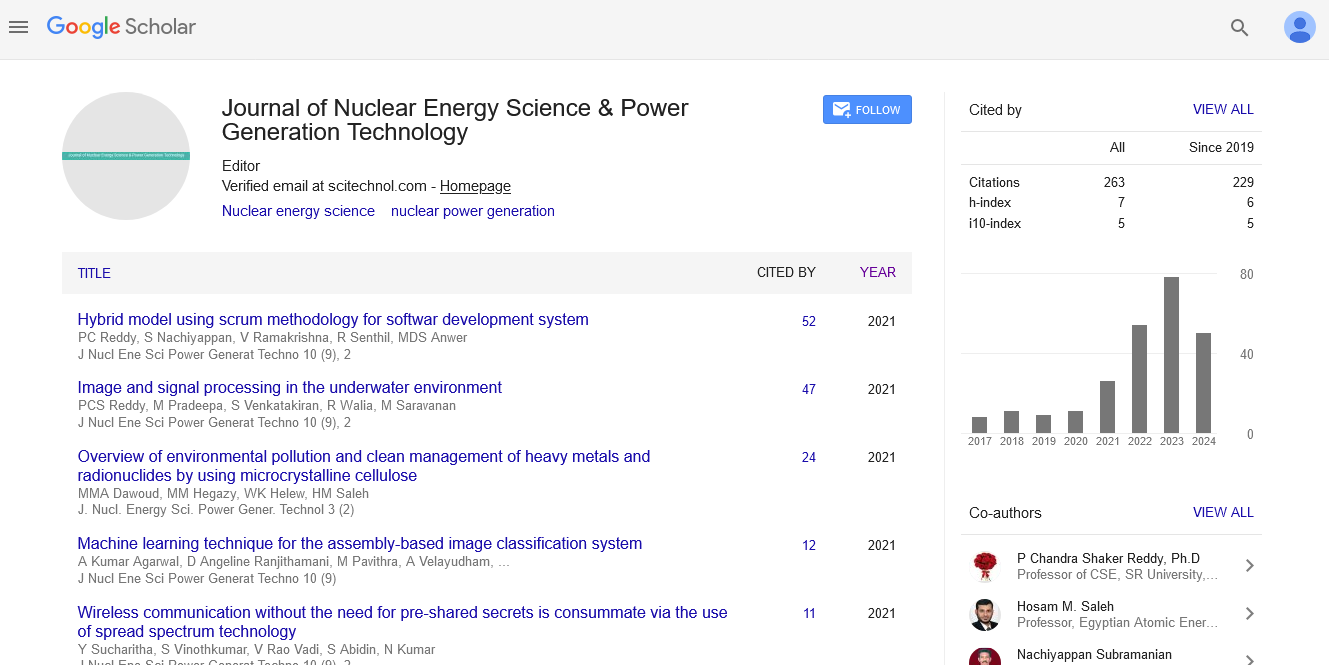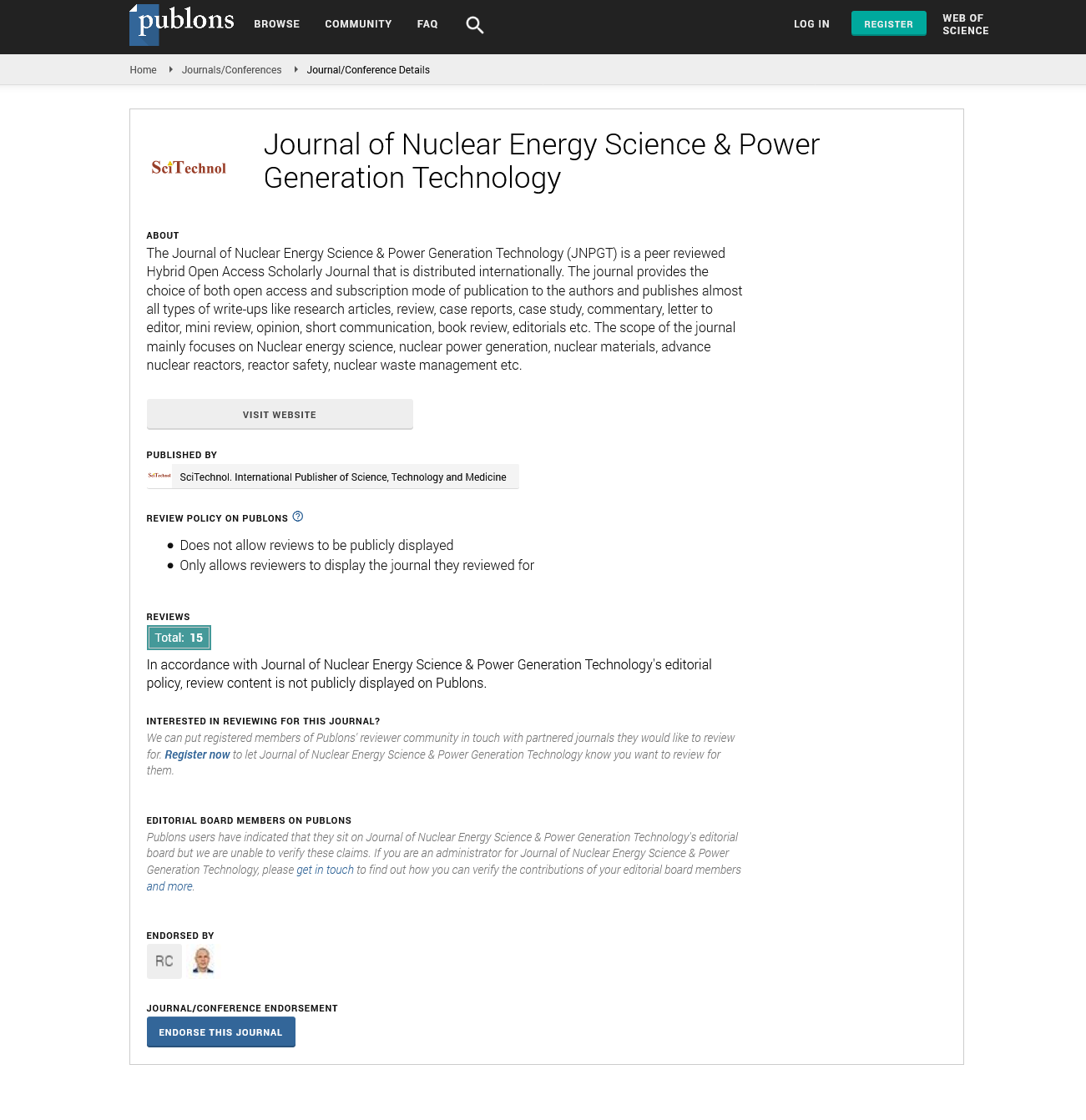Commentary, J Nucl Ene Sci Power Generat Technol Vol: 13 Issue: 5
Hydrothermal Energy Management: A Sustainable Approach to Renewable Power Generation
Fein Chen*
1Department of Energy and Power, Tsinghua University, Beijing, China
*Corresponding Author: Fein Chen,
Department of Energy and Power, Tsinghua
University, Beijing, China
E-mail: deniewe_riens@gmail.com
Received date: 26 August, 2024, Manuscript No. JNPGT-24-150263;
Editor assigned date: 28 August, 2024, PreQC No. JNPGT-24-150263 (PQ);
Reviewed date: 11 September, 2024, QC No. JNPGT-24-150263;
Revised date: 18 September, 2024, Manuscript No. JNPGT-24-150263 (R);
Published date: 25 September, 2024, DOI: 10.4172/2325-9809.1000413.
Citation: Chen F (2024) Hydrothermal Energy Management: A Sustainable Approach to Renewable Power Generation. J Nucl Ene Sci Power Generat Technol 13:5.
Description
Hydrothermal energy management refers to the process of fixing, controlling and utilizing heat stored in water from geothermal sources for energy production. It plays a significant role in renewable energy systems, utilizing the natural heat present beneath the Earth's surface to produce electricity and heating solutions. With growing concerns over climate change and the need for sustainable energy alternatives, hydrothermal energy is gaining importance as a reliable, efficient and environmentally friendly power source. Hydrothermal energy is derived from water that has been heated by the Earth's geothermal activity. These systems can be found in areas with high volcanic or tectonic activity, where underground reservoirs of water are naturally heated by the Earth's molten core. This geothermal heat elevates water to high temperatures, sometimes turning it into steam. When tapped this energy can be extracted and converted into electricity or used for heating purposes. These systems have water under high pressure that is still in liquid form and is heated to a range of 150℃ to 370℃. The heated water can be brought to the surface and passed through a heat exchanger or used directly to generate power. These systems contain steam under pressure, often over 240℃ which can be used directly to regulate turbines and generate electricity.
Hydrothermal energy management begins with the identification of suitable geothermal reservoirs. These locations are carefully assessed to ensure that they can provide a consistent and reliable supply of heated water or steam. Once identified, wells are drilled into the geothermal reservoir to bring hot water or steam to the surface. Exploration wells are drilled to tap into geothermal reservoirs. The heat, water pressure and steam content of the reservoir are measured to determine the potential for energy production. Hot water and steam are extracted from the reservoir. In some cases, a separator is used to divide the steam from water allowing the steam to be used in turbines to generate electricity. The high-pressure steam is directed into turbines where its kinetic energy is converted into mechanical energy which in turn drives electrical generators. The leftover hot water can be used for direct heating purposes such as heating homes, industrial buildings and agricultural greenhouses. Additionally, heat exchangers can be used to transfer heat from the geothermal fluid to hydrothermal energy is a renewable source of power that relies on the Earth’s internal heat, which is constantly replaced. Unlike fossil fuels, it does not deplete finite resources. Hydrothermal systems produce minimal greenhouse gas emissions compared to coal, oil and natural gas. The direct conversion of steam to electricity ensures a clean energy process. Hydrothermal plants operate with high energy efficiency, typically exceeding 90% when combined with direct heating applications. Geothermal energy is available 24/7, unlike solar or wind energy, which can fluctuate depending on environmental conditions. This makes hydrothermal energy a highly reliable base-load energy source.
Conclusion
Advancements in hydrothermal energy management aim to overcome the geographical limitations and improve efficiency. Enhanced Geothermal Systems (EGS) represent one such innovation, where artificial reservoirs are made in areas without natural hydrothermal activity. EGS involves fracturing hot dry rock formations, injecting water to generate steam and then using the steam to generate electricity. Other technologies such as binary cycle power plants allow for the generation of power from lower-temperature geothermal fluids making it possible to use energy from previously inaccessible sources. Hydrothermal energy management provides a sustainable and efficient way to utilize the Earth's natural heat for electricity and heating applications. Although challenges remain, continued research and development in geothermal technologies provide the potential for broader adoption of this renewable energy source. As the world transitions to cleaner energy systems, hydrothermal power will perform an important role in reducing greenhouse gas emissions and securing energy independence.
 Spanish
Spanish  Chinese
Chinese  Russian
Russian  German
German  French
French  Japanese
Japanese  Portuguese
Portuguese  Hindi
Hindi 

